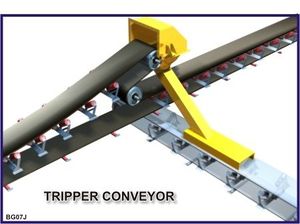Difference between revisions of "Tripper Conveyors"
(Created page with "Category:Conveying{{Knoppen}} <noinclude><!------------------------------------------------ * READ THIS FIRST * Only edit this page if you can improve the content. * Imprope...") |
m |
||
| (5 intermediate revisions by the same user not shown) | |||
| Line 1: | Line 1: | ||
[[Category:Conveying]]{{Knoppen}} | [[Category:Belt Conveying]]{{Knoppen}} | ||
<noinclude><!------------------------------------------------ | <noinclude><!------------------------------------------------ | ||
* READ THIS FIRST | * READ THIS FIRST | ||
| Line 7: | Line 7: | ||
* Please start editing this page after the /noinclude | * Please start editing this page after the /noinclude | ||
* -------------------------------------------------></noinclude> | * -------------------------------------------------></noinclude> | ||
This | [[File:Tripper_Conveyor.jpg | thumb | right | Tripper Conveyor ]] | ||
A '''Tripper Conveyor''' is a form of [[Conveyor Belts|conveyor belt]] used in construction, mining, and other large-scale earth-moving businesses. They are also known as tiered or stepped conveyers, and the term "tripper" is a colloquialism that formed after they came into widespread use. This particular type of conveyor was designed to ferry debris, earth, rocks, etc, uphill. In order to keep these materials from sliding back down the [[Conveyors|conveyor]], tall ridges or flaps were affixed laterally to the face of the conveyor belts. Workers watched the occasional rock or pebble come tripping back down one flap only to trip over the next and the name stuck. | |||
==Design== | |||
Early tripper conveyors used canvas belts, but now they're made from more flexible and durable plastics. Each belt is sealed at the ends, roughly 2 feet wide by 16 long. A flap is affixed every 4 feet. Keeping the belts taut are shafts or rollers slipped through either end. They're held off the ground by a more solid metal framework. A cog is attached to the outer end of each roller, and a metal chain, much akin to that found on a bicycle, attaches them. One section of belt attaches by means of yet another cog and chain to the next for as long as needed for the tripper conveyor to serve its purpose in transporting materials. | |||
==Function== | |||
Although the conveyors move by a repeating series of linkages between rollers, the power source of these linkages is not always the same. Initially, large diesel motors were used. The motor's flywheel would connect to a gear exchange called a speed reducer to give the first roller in the series the low speed and high torque required to move so much weight. However, the chains between cogs would often break under the strain. For that reason, newer model tripper conveyors have a smaller motor attached to the underside of the conveyor for every hundred yards of belt. While this increases consumption of fuel, it lessens time wasted in repairing damaged parts because the conveyor remains functional to some degree. | |||
==Video== | |||
<youtube>npN5cW4vtVE</youtube> | |||
Latest revision as of 08:59, 8 May 2012
A Tripper Conveyor is a form of conveyor belt used in construction, mining, and other large-scale earth-moving businesses. They are also known as tiered or stepped conveyers, and the term "tripper" is a colloquialism that formed after they came into widespread use. This particular type of conveyor was designed to ferry debris, earth, rocks, etc, uphill. In order to keep these materials from sliding back down the conveyor, tall ridges or flaps were affixed laterally to the face of the conveyor belts. Workers watched the occasional rock or pebble come tripping back down one flap only to trip over the next and the name stuck.
Design
Early tripper conveyors used canvas belts, but now they're made from more flexible and durable plastics. Each belt is sealed at the ends, roughly 2 feet wide by 16 long. A flap is affixed every 4 feet. Keeping the belts taut are shafts or rollers slipped through either end. They're held off the ground by a more solid metal framework. A cog is attached to the outer end of each roller, and a metal chain, much akin to that found on a bicycle, attaches them. One section of belt attaches by means of yet another cog and chain to the next for as long as needed for the tripper conveyor to serve its purpose in transporting materials.
Function
Although the conveyors move by a repeating series of linkages between rollers, the power source of these linkages is not always the same. Initially, large diesel motors were used. The motor's flywheel would connect to a gear exchange called a speed reducer to give the first roller in the series the low speed and high torque required to move so much weight. However, the chains between cogs would often break under the strain. For that reason, newer model tripper conveyors have a smaller motor attached to the underside of the conveyor for every hundred yards of belt. While this increases consumption of fuel, it lessens time wasted in repairing damaged parts because the conveyor remains functional to some degree.
Video
